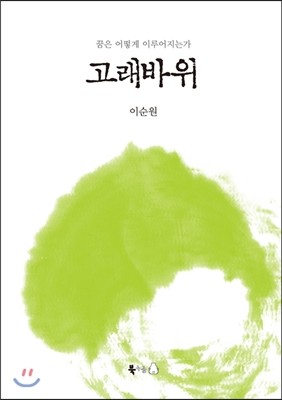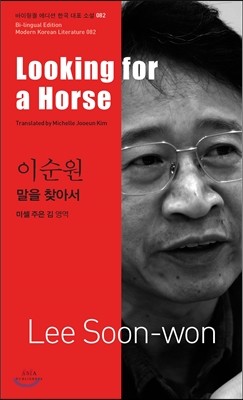Lee Soon-won (born 1957) is a modern South Korean writer.
Life
Lee Soon-won was born in Gangneung, Gangwon Province. He made his literary debut in 1985, winning the Gangwon Ilbo New Writer's Contest with his short story "So" (소 Oxen). In 1988 he won the monthly Literature and Thought New Writer's Contest with his short story "Natdal" (낮달 Day Moon). He won the 1996 Dong-in Literary Award for Susaek,eomeoni gaseumsogeuro heureuneun muni (수색, 어머니 가슴속으로 흐르는 무늬, Susaek, the Pattern of my Mother's Heart), and the 2000 Lee Hyoseok Literary Award for "Abiui jam" (아비의 잠 Father's Sleep).
Lee is a prolific writer whose works include the short story collections Geu yeoreumui kkotge (그 여름의 꽃게 The Crabs of That Summer), Eolgul (얼굴 Face), Mareul chajaseo (말을 찾아서 Looking for a Horse), Eunbiryeong (은비령 Eunbiryeong Pass), the novels Apgujeongdongen bisangguga eopda (압구정동엔 비상구가 없다 There is No Exit in Apgujeong District), Susaek, geu mulbit muni (수색, 그 물빛 무늬 Susaek, the Pattern of Water), 19se (19세 Nineteen), and Satporoui yeoin (삿포로의 여인 The Woman from Sapporo). He is the recipient of the Hyundae Literarary Award, the Hahn Moo-Sook Literary Award, and the Hwang Sun-won Literary Award, among others.
Writing
Lee Soon-won's work is populated with characters who lead a life of consumption outside of the limitations of established society or traditional order. These characters serve as the canvas upon which the values and lifestyle of the new popular consumer society are sketched. By showing the ultimate emptiness and meaninglessness of such lives, Lee assesses the new world pessimistically.
Lee's literary world is as diverse and hard to categorize as his background. He has lived in both urban and rural areas, deep in the mountains and in the seaside towns, and has developed a wide range of interests from the tradition of Confucian culture to advertising. Consequently, his works exhibit a great spectrum of literary concerns. In Apgujeongdongen bisangguga eopda, Lee explores the radical idea of terrorism as a possible response to the corruption in capitalist culture. "Eolgul" is a short story about the Gwangju Uprising, while Sunsu (순수 Innocence) is a serial novel that depicts the lives of women scarred by either direct or indirect acts of violence. 19se is an autobiographical novel that belongs to the genre of Bildungsroman. One of the author's experiences fictionalized in the book is a two-year stint of high-altitude farming. As a youth, Lee Soon-won entered Gangneung Vocational High School with hopes of working for the Bank of Korea. Being left-handed, however, he could not keep up with the abacus skills of his fellow students and decided to take up farming instead. He quit school and stuck it out in Daegwallyeong for two years, but the rigors of farming were such that he eventually returned to complete his education.
Though diverse in subject matter, Lee Soon-won's works share the underlying concern with growing insensitivity to violence and change in modern society and our indifference to the suffering of others. Over the years, however, the sharply critical tone of his works has grown relatively mild. Susaek, geu mulbit muni, published in 1996, marks a point of change in the author's perspective from cold and analytical to warm and compassionate, painting a moving story of family hardships and maternal love that also explores the negative side effects of rapid industrialization.
Lee Sun-won wurde in dem kleinen Bergdorf Uichonri in Gangnung, in der Provinz Gangwon geboren. In der Familie von Lee Sun-won stand die strenge Familienmoral, basierend auf dem traditionellen Konfuzianismus, im Vordergrund. 1980 wurde er in die Armee eingezogen. Seine Erfahrungen findet sich in zahlreichen Motiven seiner Frühwerken wieder. Lee Sun-won war der Meinung, die Armee sei der Nährboden für Widerspruch, Korruption und gewaltsame Autorität. Ferner glaubte er, die Krankheiten der Armee stünden in Zusammenhang mit den strukturellen Problemen der Gesellschaft. In seinen frühen Werken konzentrierte er sich darauf, nach soziale Widersprüche und Korruption zu forschen. Nach der Veröffentlichung von Wasserfarbe, das Muster des Wassers, die sich mit gesellschaftlichen Themen beschäftigen, stand in den Werken Wasserfarbe (Fortsetzungsroman), Eunbiryeong, Auf der Suche nach dem Maultier, Der Weg, den ich gemeinsam mit meinem Sohn gehe und schließlich Reinheit die Empfindsamkeit im Mittelpunkt.
Sus obras están llenas de personajes que llevan una vida de consumo fuera de las limitaciones establecidas por la sociedad o el orden tradicional. Estos personajes sirven como el lienzo sobre el que se bosquejan los valores y el estilo de vida de la nueva sociedad de consumo. Al mostrar el vacío y sinsentido de esas vidas, Lee Soon-won valora la vida contemporánea de forma pesimista.3Su mundo literario es diverso y difícil de categorizar. Ha vivido en áreas urbanas y rurales, en las montañas y en pueblos de la costa, y tiene una gran variedad de intereses, desde la tradición confuciana a la publicidad. Por eso sus obras muestran una gran cantidad de temas literarios. En "No hay salida en el distrito de Apgujeong", explora la idea radical del terrorismo como posible respuesta a la corrupción en la cultura capitalista. "Cara" es un relato sobre la Revolución Democrática del 19 de mayo, y Diecinueve años es una novela autobiográfica que pertenece al género de la novela de formación. Inocencia es una novela en entregas que describe la vida de una mujer que es herida por actos directos o indirectos de violencia.4Aunque trata temas diversos, sus obra comparte una preocupación subyacente por la creciente insensibilidad a la violencia y al cambio en la sociedad moderna y nuestra indiferencia al sufrimiento de los demás. Con el paso de los años el tono crítico de sus obras se ha suavizado. El color del agua, el diseño de esa tonalidad, publicado en 1996, marca un punto de cambio en la perspectiva del autor, de ser fría y analítica a ser cálida y compasiva. El color del agua, el diseño de esa tonalidad es una conmovedora historia sobre las dificultades de una familia y el amor maternal, en la que también explora los efectos negativos de la rápida industrialización.
L'œuvre de Yi Sun-won est peuplée de personnages qui vivent le plus souvent dans la surconsommation, au-delà même des limites autorisées par la société ou les traditions. Cette caractéristique est en quelque sorte la toile de fond de beaucoup de ses récits. C'est dans ce contexte que l'auteur esquisse les valeurs et les nouveaux mode de vie de la nouvelle société coréenne. En montrant le vide et le non-sens de ce mode de vie, il porte sur ce nouveau monde un jugement nettement pessimiste2.Son monde littéraire est à la fois varié et difficile à classer. Il a vécu à la fois dans les zones urbaines et rurales, en montagne, en ville, et en bord de mer, et il a développé une large gamme d'intérêts qui vont des traditions de la culture confucéenne jusqu'à l'univers de la publicité. Par conséquent, ses œuvres présentent un grand éventail de sujets. Dans son récit Il n'y a pas de sortie de secours dans le quartier Apgujeong (Apgujeongdong-en bisang-guga eopda), il explore les possibilités du terrorisme comme réponse possible à la corruption dans une société capitaliste. Visage est une nouvelle sur le soulèvement démocratique du 19 mai en Corée du Sud et Dix-neuf ans (sipguse) est un roman autobiographique. Innocence (Sunsu) est un roman-feuilleton qui dépeint la vie des femmes meurtries par des actes de violence directe ou indirecte.
Bien que la diversité des sujets traités soit indéniable, les œuvres de Yi Sun-won partagent cette préoccupation sous-jacente pour l'insensibilité croissante face à la violence et à la souffrance des autres. Au fil des ans, cependant, le ton très critique de ses œuvres s'est relativement adouci. Susaek, cette ombre d'eau (Susaek, geu mulbit munui) publié en 1996 marque un changement important du point de vue de l'auteur qui adopte une façon de voir les choses plus chaleureuse et plus compatissante. Susaek (nom d'un quartier de Séoul signifiant couleur d'eau), cette ombre d'eau est une histoire émouvante sur les difficultés familiales et sur l'amour maternel, récit qui explore également les effets secondaires de l'industrialisation rapide en Corée du Sud.
1958年5月2日、江原道江陵市に生まれる。李は様々なテーマと素材、文体を操ることができるため、彼の文学世界は一言では表現できない多様さがある。李は自ら伝統的な儒教文化から資本主義の中心である広告分野に至るまでの様々な興味ごと、海辺と山間地域、都市と農村を広く経験したことが自分の文学人生において大いに役立ったと説明する。資本主義の堕落した欲望をテロで抑圧するという急進的な観点の小説『압구정동엔 비상구가 없다(狎鷗亭洞には非常口がない)』、光州民主化抗争をテーマにした短編『얼굴(顔)』、中年男女の愛の話『은비령(隱秘嶺)』、自分の10代の成長期の体験を描いた『19세(19歳)』、直接的また間接的な暴力で傷ついた女性たちの姿を通じて歪な性の社会史を描いた『순수(純粋)』、三流人生を生きる現代の若者のライフと恋を描いた長編『모델(モデル)』まで、李が小説で扱うテーマは実に幅広い。李の小説の一貫した特徴は、暴力と変化に無感覚になりつつある現代社会に対する悲観的な認識を描いていることだ。しかし、初期の作品にみえた冷静な視線は1996年発表した『수색 그 물빛 무늬(水色、その水模様)』から比較的に暖かい視線に変わった。同小説は、「水色」という町を背景に5兄弟を育ててきた母に対する描写が感動を与えた作品で、家族の和解を描きながらも、現代社会の急速な変化と開発に対する批判も盛り込まれている。
이순원(1958~)은 대한민국의 소설가다.
생애
이순원은 1958년 강원도 강릉에서 태어났다. 강원대 경영학과를 졸업했다. 1985년 《강원일보》 신춘문예에 단편 〈소〉가 당선되었고, 1988년 《문학사상》에 발표한 단편 〈낮달〉로 신인상을 받으며 작품 활동을 시작했다. 1983년 금융기관에 취직해서 편집, 홍보분야의 일을 10여년 하다가, 1994년 그만두고 전업 작가로 지내고 있다. 1996년 《수색, 어머니 가슴속으로 흐르는 무늬》로 동인문학상을, 2000년 〈아비의 잠〉으로 이효석문학상을 수상했다. 작가의 작품 중 <19세>, <은비령>, <아들과 함께 걷는 길>, <수색, 그 물빛 무늬>, <그가 걸음을 멈추었을 때> 등이 드라마로 만들어졌다. 작가는 2010년 ‘강릉 바우길’ 만들기에 참여했고, 김유정문학관의 관장으로 일하는 등 창작 외에 다양한 활동을 하고 있다.
작품 세계
이순원은 타락한 자본주의와 1980년 광주 민주화운동으로 대변되는 국가 폭력의 문제, 가족의 갈등과 화해 등 다양한 삶의 문제를 소설의 주제로 삼아왔다. 한국 자본주의의 병폐와 천민자본주의에 대한 비판적인 시각을 토대로 압구정동의 욕망과 타락을 파헤친 《압구정동엔 비상구가 없다》(1992), 1990년대 식 사랑의 청순함과 사랑을 통한 성장의 과정을 담은 《미혼에게 바친다》(1995), 옛것에 대한 기억을 통해 현대사회를 비판하며 가족의 화해와 유대를 보여주는 《수색 그 물빛 무늬》(1996), 이야기체 소설을 통해 주인공의 삶을 전개한 《해파리에 관한 명상》(1998), 시골학교의 정겨움과 초등학교 시절 첫사랑이 담긴 《첫사랑》(2000) 등 다수의 작품으로 작가의 경향을 알 수 있다. 《수색 그 물빛 무늬》(1996) 이전의 작품들이 현실에 대한 비판의 발언이 강하다면 그 이후의 작품들은 구체적 삶의 체험과 내면세계가 밀도 있게 그려져 있다.
장편소설 《첫사랑》(2000)에서 작가는 작가의 고향인 강릉을 배경으로 농촌의 일상이 지닌 공동체적 속성과 가치를 추억의 방식으로 복원하고 있다.
소설집 《그가 걸음을 멈추었을 때》(2003)는 도시를 배경으로 현대적이면서 과거적인 이야기를 담고 있다. 작가는 아무 것도 진행되지 않으면서 진행 중이거나 잃어버린 것과 버린 것들을 작품의 대상으로 삼아 삶의 소중한 단면들을 보여주고 있다.
장편소설 《삿포로의 여인》(2016)은 삿포로에서 태어나 대관령에 살았던 주인공과 대관령에서 태어나 삿포로에서 사는 주인공의 딸의 이야기를 통해 운명적이면서 순식간에 사라지는 사랑을 그려내고 있다.
장편소설 《오목눈이의 사랑》(2019)에서 작가는 강릉의 대관령 숲에서 우연히 들은 뻐꾸기 울음소리를 쫓아, 새들의 특성과 생태, 여정을 기록하고 이를 통해 인간이 되찾아야 할 삶의 방향을 제시하고 있다.
장편소설 《춘천은 가을도 봄》(2020)은 1970년대 후반에 춘천에서 청춘을 보냈던 한 소설가의 회고담의 형식으로 구성된 작품이다. 소설은 주인공이 시위에 참여하여 제적 처분과 기소유예를 받고 고향으로 돌아온 사건 그리고 친일행위로 재산을 축적한 주인공의 집안이 정치적으로 명예를 얻는 모습을 통해 현재 한국사회의 모순을 되돌아보고 있다.
주요 작품
1) 소설집
《은비령》, 생각의나무, 2001(개정판, 굿북, 2008).
《그 여름의 꽃게》, 세계사, 1989.
《얼굴》, 문학과지성사, 1993.
《미혼에게 바친다》, 푸른숲, 1995.
《해파리에 관한 명상》, 작가정신, 1998(개정판, 2003).
《독약 같은 사랑》, 현대문학북스, 1998.
《말을 찾아서》, 문이당, 1997.
《첫사랑》, 세계사, 2000.
《그가 걸음을 멈추었을 때》, 생각의 나무, 2003.
《나무》, 뿔, 2007.
《첫 눈》, 뿔, 2009.
2) 장편소설
《수색, 그 물빛 무늬》, 민음사, 1997(개정판, 2005)
《그대 정동진에 가면》, 민음사, 1999.
《순수》, 생각의나무, 2000.
《압구정동엔 비상구가 없다》, 중앙일보사, 1992(개정판, 청어, 2001).
《스물셋 그리고 마흔여섯》, 이가서, 2006.
《아들과 함께 걷는 길》, 해냄, 2002(개정판, 실천문학사, 2016).
《19세》, 세계사, 1999(개정판, 단비, 2022).
《삿포로의 여인》, 문예중앙, 2016.
《오목눈이의 사랑》, 해냄, 2019.
《춘천은 가을도 봄》, 자음과모음, 2020.
3) 산문집
《은빛 낚시》, 자음과모음, 2005.
《길 위에 쓴 편지》, 비앤앰, 2006.
수상 내역
1996년 제27회 동인문학상
1999년 제5회 한무숙문학상
2000년 제1회 이효석문학상
2006년 남촌문학상
2016년 제19회 동리문학상





